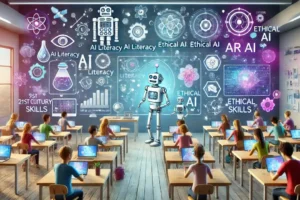
The Institutionalization of Hybrid Learning in Education
Thursday, September 8, 2022
2022 marked the beginning of a new era in education after the pandemic: the hybrid learning model became permanent. With the return of in-person classes, the power of online learning tools combined to create a flexible learning environment, especially for YKS and LGS students. EBA, Zoom, and private platforms became the cornerstones of this model. In the “Activities and Announcements” section of our website, we explore in detail the opportunities hybrid learning provides students and the difference it made in 2022. Let’s discover this new era of education together.
What is Hybrid Learning?
Hybrid learning is a combination of face-to-face and online education. In 2022, as schools fully reopened after the pandemic, many institutions adopted this model. For example, some lessons were held in the classroom, while additional resources and homework were delivered via EBA or other online platforms. This model especially made it easier for students in rural areas to access educational materials. According to the Ministry of Education, the number of schools implementing hybrid education increased by 40% in 2022.
Advantages for Students
Hybrid learning offers numerous opportunities for YKS and LGS students:
- Flexibility: Attend classes at school and review missed topics via EBA videos.
- Ease of Access: Online resources make education accessible from anywhere.
- Personalized
Learning:
Online platforms provide content tailored to students’ individual needs. - Technology Integration: Live lessons on Zoom or EBA allow students to maintain communication with their teachers.
For example, a student preparing for the YKS can learn about optics in a physics class at school, then solve related practice tests on EBA in the evening. LGS students can reinforce math lessons in class and practice with online mock exams.
Hybrid Education in Turkey and the World
In Turkey, EBA became the backbone of hybrid education. In 2022, the platform reached 18 million users and expanded with live class modules. Globally, hybrid education also became widespread, particularly in Europe and the U.S. For example, in some American schools, certain days of the week were designated for in-person classes, while others were held online. This model helped students improve both their social and digital skills.
Challenges and Solutions
Hybrid education also poses some challenges. Students in areas without internet access are unable to fully benefit from this model. In response, the Ministry of Education strengthened EBA TV and increased free tablet distribution in 2022. Additionally, in-service training was provided to help teachers adapt to the hybrid model. Parents can support the process by monitoring their children’s participation in online classes.
Tips for Students and Parents
- Join EBA live lessons regularly and rewatch the recorded sessions.
- Reinforce topics learned at school by practicing with online quizzes.
- Parents can monitor their child’s use of EBA to identify learning gaps.
- Use the mock exams available through the hybrid model for exam preparation.
Final Word
2022 was the year hybrid education became a permanent fixture in Turkey. The warmth of face-to-face instruction combined with the flexibility of online learning created new opportunities for YKS and LGS students. Dear students, take advantage of this model by utilizing EBA and other platforms. Parents, support your children as they navigate this new system. Teachers, integrate the tools offered by hybrid education into your lessons. Let’s embrace this new chapter in education and share your experiences with us.



